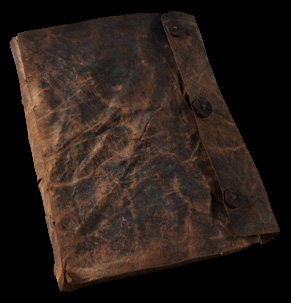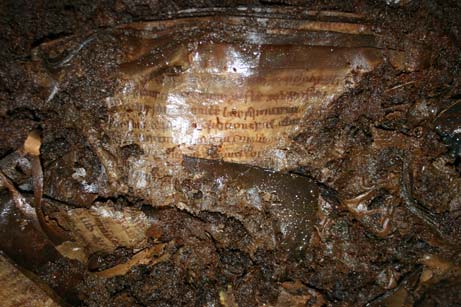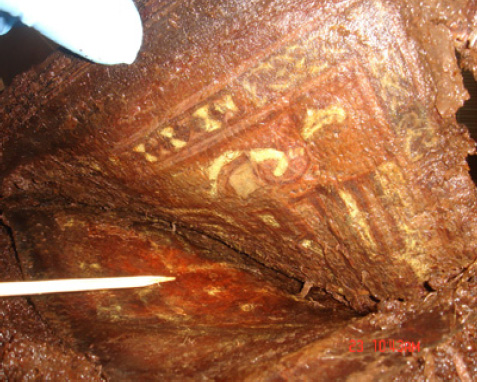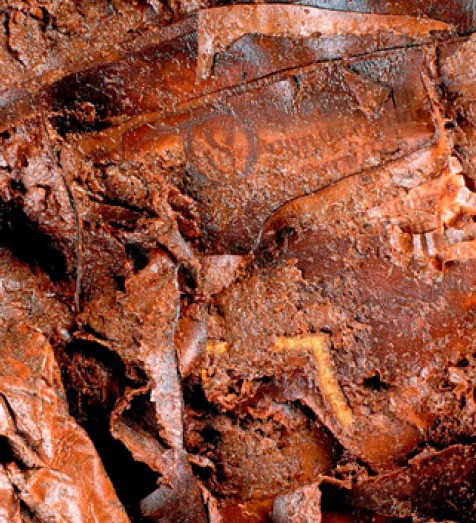Post by brillbilly on Sept 14, 2010 2:26:37 GMT 10
Ireland’s National Museum announced on Monday, September 6th 2010, the discovery of fragments of Egyptian papyrus in the leather cover of an ancient book of psalms. According to the museum ‘it is a finding that asks many questions and has confounded some of the accepted theories about the history of early Christianity in Ireland.’ Its significance may be huge, as the papyrus could be evidence of the first ‘tangible connection between early Irish Christianity and the Middle Eastern Coptic Church’, the Coptic Orthodox Church of Alexandria.

The manuscript known as the Faddan More Psalter was unearthed four years ago, on July 20th 2006, from a peat bog at Faddan More near the town of Birr in County Tipperary. The fragmented illuminated vellum manuscript is encased in an Egyptian style leather binding and dates to the eighth century. According to Raghnall O Floinn, head of collections at the Museum, it represents one of the top ten archaeological discoveries in Ireland. It was the first manuscript to be found in a water-logged state in a bog and its discovery posed unprecedented difficulties for the Conservation Department of the Museum.


Careful easing back of the text block from the front cover revealed a tantalizing glimpse of the highly decorated first page. At the time of going to press this folio remains un-treated. ©National Museum of Ireland
An orpiment border and a capital letter were among the exciting features visible before conservation commenced. ©National Museum of Ireland

About fifteen percent of the pages of the psalms, which are written in Latin, are believed to have survived. It is thought that the manuscript was produced in an Irish monastery and later placed in the Egyptian style cover. O Floinn explained that ‘the cover could have had several lives before it ended up basically as a folder for the manuscript in the bog. It could have travelled from a library somewhere in Egypt to the Holy Land or to Constantinople or Rome and then to Ireland.’
Irish scientists have analysed and restored the manuscript for the past four years. It was only as the restoration was completed this summer that the fragments of papyrus were discovered in the binding. However, many questions remain unanswered. The psalm’s leather binding appears to have come from Egypt; but did the papyrus come with the cover or was it added later? O Floinn hopes that ‘the imperfections in the hide may allow us to confirm the leather is Egyptian. We are trying to track down if there somebody who can tell us if this is possible. That is the next step.’
The Fadden More Psalter is due to go on display in the National Museum of Ireland in June 2011.
Article from: historytoday.com
--------------------------------------------------------------------------------
Treasure From the Bog
From: National Museum of Ireland
On July 20th 2006, a remarkable archaeological find was uncovered in a remote bog at Faddan More, in north Tipperary, close to the town of Birr. Local man Eddie Fogarty was cutting peat with a mechanical digger when he spotted something unusual that looked “like some sort of book”. It would be heralded by Dr. Pat Wallace, Director of Ireland’s National Museum as “the most important day in the history of the Museum since 1868 when the Ardagh Chalice came in.”
The find - which has become known as the Faddan More Psalter - was a fragmented illuminated vellum manuscript encased in an unusual leather binding, a book of psalms dating back to the late Eighth century. This unprecedented find, the first manuscript to be found in a water-logged state in a bog, posed unique and profound difficulties for the Conservation Department at the National Museum.
At the time, Dr. Wallace went on to comment that “it is not so much the fragments themselves, but what they represent, that is of such staggering importance. In my wildest hopes, I could only have dreamed of a discovery as fragile and rare as this. It testifies to the incredible richness of the Early Christian civilisation of this island and to the greatness of ancient Ireland.”
Over the last four years, Crossing The Line Films has had exclusive access to the National Museum’s team as they embarked upon this dramatic and pain-staking journey of recovery and discovery. The documentary follows leading Irish book conservator John Gillis as he set about preserving and conserving this unique find.
As the process reached its conclusion, fragments of papyrus were dramatically discovered in the lining of the Egyptian-style leather binding. This potentially represents the first tangible connection between early Irish Christianity and the Middle Eastern Coptic Church. It is a finding that asks many questions and has confounded some of the accepted theories about the history of early Christianity in Ireland.
The documentary also travels across Europe and to the deserts of Egypt as they tried to uncover the story behind this perplexing and mysterious discovery.
redicecreations.com/article.php?id=12504


The manuscript known as the Faddan More Psalter was unearthed four years ago, on July 20th 2006, from a peat bog at Faddan More near the town of Birr in County Tipperary. The fragmented illuminated vellum manuscript is encased in an Egyptian style leather binding and dates to the eighth century. According to Raghnall O Floinn, head of collections at the Museum, it represents one of the top ten archaeological discoveries in Ireland. It was the first manuscript to be found in a water-logged state in a bog and its discovery posed unprecedented difficulties for the Conservation Department of the Museum.


Careful easing back of the text block from the front cover revealed a tantalizing glimpse of the highly decorated first page. At the time of going to press this folio remains un-treated. ©National Museum of Ireland
An orpiment border and a capital letter were among the exciting features visible before conservation commenced. ©National Museum of Ireland

About fifteen percent of the pages of the psalms, which are written in Latin, are believed to have survived. It is thought that the manuscript was produced in an Irish monastery and later placed in the Egyptian style cover. O Floinn explained that ‘the cover could have had several lives before it ended up basically as a folder for the manuscript in the bog. It could have travelled from a library somewhere in Egypt to the Holy Land or to Constantinople or Rome and then to Ireland.’
Irish scientists have analysed and restored the manuscript for the past four years. It was only as the restoration was completed this summer that the fragments of papyrus were discovered in the binding. However, many questions remain unanswered. The psalm’s leather binding appears to have come from Egypt; but did the papyrus come with the cover or was it added later? O Floinn hopes that ‘the imperfections in the hide may allow us to confirm the leather is Egyptian. We are trying to track down if there somebody who can tell us if this is possible. That is the next step.’
The Fadden More Psalter is due to go on display in the National Museum of Ireland in June 2011.
Article from: historytoday.com
--------------------------------------------------------------------------------
Treasure From the Bog
From: National Museum of Ireland
On July 20th 2006, a remarkable archaeological find was uncovered in a remote bog at Faddan More, in north Tipperary, close to the town of Birr. Local man Eddie Fogarty was cutting peat with a mechanical digger when he spotted something unusual that looked “like some sort of book”. It would be heralded by Dr. Pat Wallace, Director of Ireland’s National Museum as “the most important day in the history of the Museum since 1868 when the Ardagh Chalice came in.”
The find - which has become known as the Faddan More Psalter - was a fragmented illuminated vellum manuscript encased in an unusual leather binding, a book of psalms dating back to the late Eighth century. This unprecedented find, the first manuscript to be found in a water-logged state in a bog, posed unique and profound difficulties for the Conservation Department at the National Museum.
At the time, Dr. Wallace went on to comment that “it is not so much the fragments themselves, but what they represent, that is of such staggering importance. In my wildest hopes, I could only have dreamed of a discovery as fragile and rare as this. It testifies to the incredible richness of the Early Christian civilisation of this island and to the greatness of ancient Ireland.”
Over the last four years, Crossing The Line Films has had exclusive access to the National Museum’s team as they embarked upon this dramatic and pain-staking journey of recovery and discovery. The documentary follows leading Irish book conservator John Gillis as he set about preserving and conserving this unique find.
As the process reached its conclusion, fragments of papyrus were dramatically discovered in the lining of the Egyptian-style leather binding. This potentially represents the first tangible connection between early Irish Christianity and the Middle Eastern Coptic Church. It is a finding that asks many questions and has confounded some of the accepted theories about the history of early Christianity in Ireland.
The documentary also travels across Europe and to the deserts of Egypt as they tried to uncover the story behind this perplexing and mysterious discovery.
redicecreations.com/article.php?id=12504








 Happy New Years Everybody!!!
Happy New Years Everybody!!!
